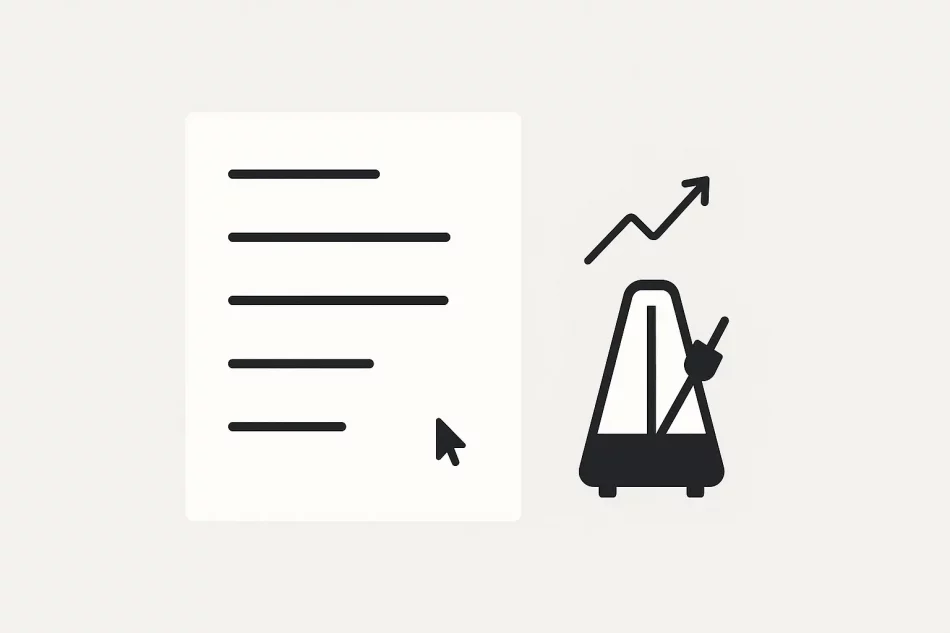TL;DR: Don’t chase a magic number. Aim for an average of ~12–18 words, then mix lengths on purpose: many short and medium sentences, a few longer ones when the reader is “rested.” That mix improves clarity, rhythm, and engagement—signals search engines notice.
You probably write sentences that are all the same length. It feels neat. It reads dull. And dull costs you time on page, backlinks, and trust. The fix isn’t more adjectives—it’s a metronome you control.
What “optimal sentence length” really means
There isn’t one length. There’s tempo. Short sentences move. Longer ones connect ideas—use them sparingly and clearly. When every line is medium, your prose turns to porridge: warm, uniform, forgettable.
Three quick questions to expose blind spots:
- Where should the reader speed up—and where must they slow down?
- Which sentence can you split without losing meaning?
- What idea actually needs a longer line because it carries cause → effect?
Answer them, then cut or combine. Momentum over ornament.
A fast rule of thumb
- Target average: ~12–18 words.
- Mix: ~60% medium (11–18), ~30% short (≤10), ~10% longer (24–30).
- Purpose: Short earns attention; long spends it—to buy nuance.
Pro tip: Short sentences earn attention. Long sentences spend it. Spend wisely.
Pro tip 2: Variety creates velocity—and velocity creates comprehension.
A 90-second edit you can run on any draft
Step 1: Map the rhythm. Skim a paragraph and mark S (short), M (medium), L (long). If you see MMMM or LLL, you’ve got drag.
Step 2: Break or bridge.
- Break one long sentence at the natural pivot (usually after because/so/but).
- Bridge two choppy sentences with a precise connector (not fluff): “so,” “but,” “therefore,” “which means.”
Step 3: Land the point. Put the punch where it matters—often as a short line at the end.
Before (draggy):
“If your product page reads like a legal memo, readers bounce because the logic takes work, and that drop in engagement tells search engines the page isn’t delivering, which quietly suppresses the keywords you care about.”
After (alive):
“Your product page reads like a memo. Readers bounce. Search engines notice. The fix isn’t tricks—it’s sentences your audience can ride without stalling.”
Why this helps SEO without gaming SEO
Search engines don’t reward you for 14-word sentences. They reward reader behavior—clicks that stay, scrolls that continue, links that stick. Clear rhythm improves comprehension, which improves engagement. Engagement lifts everything else.
Objection: “But long sentences are bad for SEO.”
Answer: Sloppy ones are. A well-structured 28-word sentence that connects cause to effect beats five staccato lines that scatter the point. Use long when it pays the reader back.
A tiny, real-world detail you can measure
Run a quick pass on a 1,200-word post and drop your average from ~22 words to ~15 while adding two clean long sentences. You’ll feel the difference as you read aloud—and you’ll see it in scroll depth. Not magic. Mechanics.
Use this when it counts
- Introductions: short lines to hook; one longer line to frame the problem.
- Explanations: medium cadence; a long line to show relationships; a short line to land it.
- Calls to action: almost always short.
Where this breaks: If the idea is muddy, rhythm won’t save it. Fix the thought, then fix the sentences.
One-page checklist
- Average between 12–18 words.
- Ensure visible variety: S/M/M/S/M/L… not M/M/M/M.
- Split anything past ~22 words unless connection value is high.
- Use real connectors: because, so, but, therefore.
- End sections with a short, clear punch—no throat clearing.
FAQ: sentence length & readability
What’s the best sentence length for web writing?
There isn’t a single best number. Aim for a ~12–18-word average with deliberate variety.
Are short sentences always better?
No. Short lines speed readers up; longer ones connect ideas. Use both on purpose.
How do I check sentence length fast?
Run your draft through any editor that shows words per sentence, then adjust: split >22-word lines unless they earn their keep.
You started with uniform lines. You’ll finish with control: short to pull me forward, long to show me why it matters. That’s how you keep readers—and how you earn the rankings you wanted in the first place.

